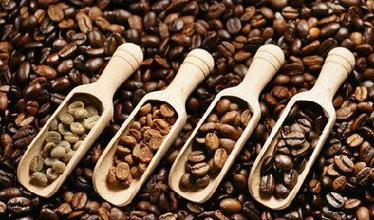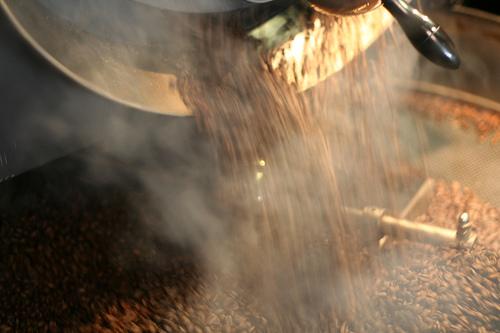The meaning of roasting and the development of roasting history distinguishing the flavor characteristics of roasting degree of raw coffee beans
First, let's talk about the meaning of baking:
1. Definition of roasting: the so-called coffee roasting (coffee roasting) refers to the heating of raw beans, which promotes a series of physical and chemical reactions inside and outside the coffee beans, and in this process produces a variety of sour, bitter, sweet and other flavors of coffee, forming mellowness and hue, and converting raw beans into dark brown beans.
two。 The importance of baking: among the factors affecting the taste of a cup of coffee, raw beans account for 60%, roasting accounts for 30%, and extraction accounts for 10%. Good roasting can maximize the personality of raw beans and minimize the occurrence of defective flavor, on the contrary, improper roasting will completely destroy good beans. Due to heating in the baking process, time, temperature control is very difficult to grasp, baking technology is a very complex technology, so the importance of baking appears to be more prominent!
History of baking:
As early as the 13th century, Arabs invented to put coffee beans in a pot, heat them and stir-fry them, then grind them into powder, and then brew coffee. Early Arabs like to bake beans shallowly and boil them with spices such as cardamom. Later, this method of coffee stir-frying spread to Syria, Turkey and Egypt, where it was used to stir-fry the coffee black, then grind it into powder, add sugar and boil it in water, pour it directly into a small cup and drink it with coffee grounds.
After coffee was introduced into Europe in the 18th century, Europeans also followed the Turkish practice of stir-frying coffee to black. Later, because of geographical and cultural differences, Europe was divided into shallow baking schools dominated by northern Europe, Germany, England and Scandinavia, and deep baking schools dominated by southern Europe. The former usually bake the beans to city-full city, while the latter generally bake them to the same depth as italy,french. Until the mid-19th century, most of Europe used iron pots or ovens to bake beans at home, and later invented small roasters that use closed iron buckets instead of iron pans and put them on the fire, and can bake a few pounds of beans at the same time. Used by some coffee shops.
In the middle and late 19th century, with the advent of large baking machines, large quantities of baked beans became possible. After the advent of large-scale roaster, after continuous innovation, electronically controlled precision instruments appeared in the first half of the 20th century, and machines that can bake 5000kg continuously every hour.
The emergence of large roasters has changed people's own baking habits. Buying packaged baked beans or coffee powder to cook directly at home facilitates the fast-paced life of modern people. In the 1960s, brand-packaged coffee beans dominated the market. But there are also problems with mass baking: raw beans of average quality, excessive shallow roasting in order to maintain weight, lack of freshness causing flavor indeed. Since the 1980s, a "boutique coffee" movement was launched in the United States. It advocates people to buy boutique raw beans, home baking, drink fresh coffee, pursue quality and taste, and home roasting begins to be valued again. The pursuit of coffee quality has also forced some big roasters to adopt higher quality beans to ensure the baking quality.
Source: happy Coffee Xiao Xu's blog
Important Notice :
前街咖啡 FrontStreet Coffee has moved to new addredd:
FrontStreet Coffee Address: 315,Donghua East Road,GuangZhou
Tel:020 38364473
- Prev

Coffee bean flavor characteristics of single mixed coffee and blended coffee
The mixed coffee here is a kind of single coffee (pure drinking coffee). As the name implies, mixed coffee is a combination of several different coffee beans. The process of combining several different coffee beans is the blending process of comprehensive coffee. The reason why there is no need to mix such words here is because the blending process of mixed coffee is not a simple mix, which depends on different coffee.
- Next

The change and degree of roasting process the flavor characteristics of roasting degree of coffee beans on the comparison table
The five stages of baking: 1. Dry, when the raw bean is heated, the water vapor in the raw bean will evaporate, and when it reaches about 135 degrees, the raw bean begins to lighten from green and gradually whitens. two。 Dehydration, as heating, raw beans from green to light yellow, when the temperature is about 160 degrees, will emit the smell of grass, or the aroma of baked grain, continuous heating, beans will turn light brown. 3. one
Related
- What is the meaning of lactic acid fermentation with coffee bean treatment?
- How to judge the state of foam by sound?
- How does the latte pull out the unicorn pattern? Come to get for a little trick to improve the flower pull!
- Will flower pulling affect the taste of the latte?
- Do you know the history of coffee?
- The difference between honey treatment and sun washing what is raisin honey treatment?
- What kind of milk can a novice use to make coffee foam to keep the foam longer? The correct method and skills of milking tutorial sharing
- Why do washed coffee beans taste sour? Flavor characteristics of washed Coffee
- Introduction to the skill of how to practice the size and height of water injection around the circle of hand-brewed coffee
- How do beginners practice coffee flower drawing from scratch?

